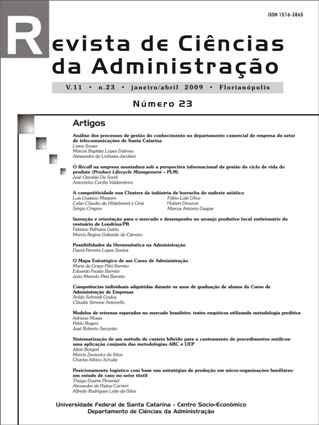A competitividade nos Clusters da indústria de borracha do sudeste asiático
DOI:
https://doi.org/10.5007/2175-8077.2009v11n23p65Resumen
O objetivo deste trabalho é estudar a competitividade do setor manufatureiro de produtos de borracha da Malásia, através da análise da indústria de luvas médicas. A articulação entre o setor produtivo e o Estado privilegiou a atração de investimentos estrangeiros, o foco nas exportações, a busca da competitividade através da produtividade e da melhor utilização dos recursos. Essas práticas são coerentes com a Teoria dos Aglomerados, pois enfatizam justamente o crescimento sustentado da produtividade e da competitividade, e não a concessão de vantagens temporárias ou concentração empresarial. Tem sido expressiva a atuação das instituições especializadas de pesquisa tecnológica e das associações dos fabricantes para fins de normatização, melhora da qualidade e promoção do produto no exterior. O caso pode servir de contraponto para avaliação das estratégias para o desenvolvimento industrial no Brasil.
Descargas
Publicado
Cómo citar
Número
Sección
Licencia
El autor deberá garantizar:
- que exista pleno consenso entre todos los coautores para aprobar la versión final del documento y su envío para publicación.
que su trabajo es original, y si se utilizó trabajo y/o palabras de otras personas, estos fueron debidamente reconocidos.
El plagio en todas sus formas constituye un comportamiento editorial poco ético y es inaceptable. RCA se reserva el derecho de utilizar software o cualquier otro método de detección de plagio.
Todos los envíos recibidos para evaluación en la revista RCA pasan por la identificación de plagio y autoplagio. El plagio identificado en los manuscritos durante el proceso de evaluación dará lugar al archivo del envío. Si se identifica plagio en un manuscrito publicado en la revista, el Editor Jefe realizará una investigación preliminar y, de ser necesario, se retractará.
Los autores otorgan a RCA los derechos exclusivos de primera publicación, estando la obra licenciada simultáneamente bajo la Licencia Creative Commons (CC BY) 4.0 Internacional.

Los autores están autorizados a celebrar contratos adicionales por separado, para la distribución no exclusiva de la versión del trabajo publicado en esta revista (por ejemplo, publicación en un repositorio institucional, en un sitio web personal, publicación de una traducción o como capítulo de un libro), con reconocimiento de autoría y publicación inicial en esta revista.
Esta licencia permite a cualquier usuario tener derecho a:
Compartir: copiar, descargar, imprimir o redistribuir el material en cualquier medio o formato.
Adapte: remezcle, transforme y cree a partir del material para cualquier propósito, incluso comercial.
Bajo los siguientes términos:
Atribución: debe dar el crédito apropiado (citar y hacer referencia), proporcionar un enlace a la licencia e indicar si se realizaron cambios. Debe hacerlo bajo cualquier circunstancia razonable, pero de ninguna manera que sugiera que el licenciante lo respalda a usted o su uso.
Sin restricciones adicionales: no puede aplicar términos legales ni medidas tecnológicas que restrinjan legalmente a otros hacer algo que la licencia permite.


